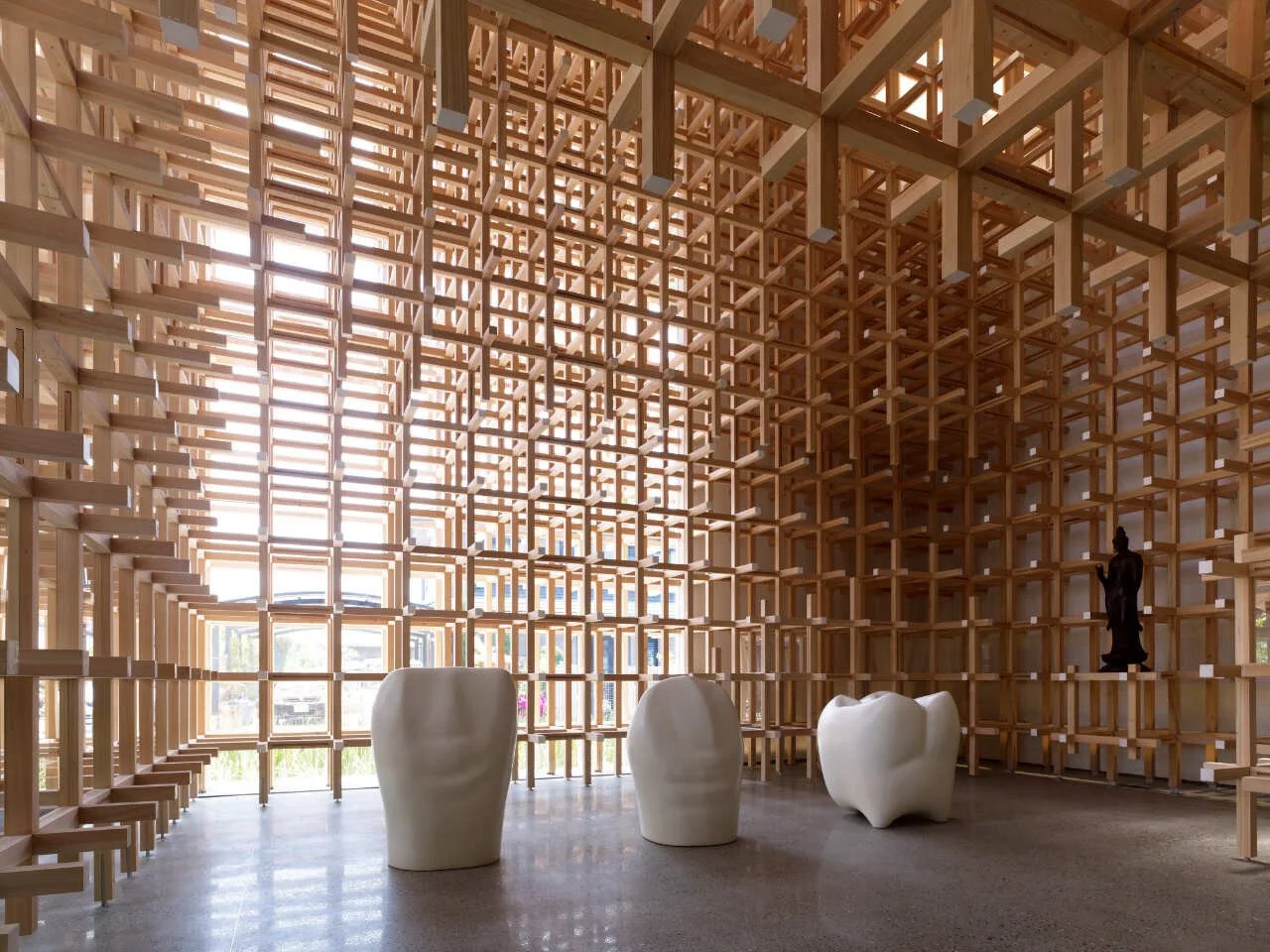Discover how traditional Japanese architecture, with its emphasis on simplicity, sustainability, and harmony with nature, can inspire the design of net-zero homes.
Cardboard Cathedral / Shigeru Ban. PHOTO: Stephen Goodenough on Archdaily
Driven by the pressing need to reduce our environmental impact, the concept of net-zero homes is gaining significant traction. These innovative homes aim for a remarkable feat: achieving net-zero energy consumption and minimizing environmental footprint.
Interestingly, the principles behind net-zero homes resonate with elements found in many ancient architectural traditions, particularly Japanese architecture. Renowned for its focus on environmental mindfulness and natural beauty, traditional Japanese architecture prioritizes simplicity and elegance, creating uncluttered spaces that promote a connection with nature.
Delving into the beauty of traditional Japanese architecture, this article explores how these time-tested principles can be adapted for sustainable modern homes, especially net-zero homes.
Core Principles of Traditional Japanese Architecture
Rooted in a deep respect for nature and a philosophy of harmonious living, traditional Japanese architecture offers a timeless approach to design that emphasizes simplicity, flexibility, and sustainability.
Simplicity and Harmony with Nature
Japanese architecture values simplicity. This is achieved by removing unnecessary elements or ornamentation, resulting in a feeling of lightness, openness, and a comfortable environment. This design principle, woven into the fabric of Japanese culture for centuries, influences not just aesthetics but also the emphasis on simplicity in everyday life.
It is characterized by the careful selection and arrangement of natural materials like wood, stone, and paper, along with the use of clean lines. Large windows, sliding doors, and open spaces further emphasize this connection to nature by flooding the interior with abundant natural light and facilitating air circulation to cool the space.
Additionally, traditional houses often feature gardens, creating a seamless transition between indoor and outdoor spaces and allowing occupants to feel closer to nature. This approach exemplifies the holistic philosophy of sustainable architecture.
Tadao Ando’s Minimalist Spaces
Renowned for his minimalist approach and masterful integration of natural elements, Japanese architect Tadao Ando incorporates simple geometric forms and natural materials into his designs. Light and water become key elements in his work, infusing concrete spaces with a profound sense of tranquility and serenity.
The Chichu Art Museum is one of Ando’s most famous works and was built in 2004 on the island of Naoshima, Japan. This museum is built mostly underground to minimize its impact on the natural surroundings and is designed to interact with the natural light and landscape, creating a serene and contemplative environment for visitors.
Flexibility and Multi-functionality
Japanese architecture is renowned for its focus on flexibility and multi-functionality. This approach stems from the country’s historical experience of limited resources and a large population. Faced with these challenges, Japanese designers developed unique ways to understand and utilize limited space. Traditional Japanese housing exemplifies this with its use of tatami mats and shoji screens, creating flexible and adaptable living areas.
Tatami & Shoji for Flexible Living
Traditionally used in Japanese homes, tatami mats are woven straw floor coverings, typically rectangular in shape. These mats can be easily assembled, rearranged, and moved, contributing to the flexibility of Japanese living spaces. Additionally, tatami mats are known for their ease of cleaning.
Shoji screens, on the other hand, are translucent paper or fabric panels mounted on a wooden frame that function as sliding doors or room dividers. They are used to divide spaces, create privacy, and control the flow of light and air. Lightweight and easily moved, shoji screens allow for quick adjustments to room size and function, adapting the layout to changing needs.
Shigeru Ban’s Adaptable Structures
One Japanese architect known for integrating flexibility and multi-functionality into designs is Shigeru Ban. He is renowned for his innovative use of materials, particularly cardboard tubes, to create versatile, adaptable structures that address various needs while also being environmentally sustainable. He believes that architecture should be responsive to the user’s needs and conditions and should be designed to improve people’s lives.
The Paper Log House in Kobe, Japan, and the Cardboard Cathedral in Christchurch, New Zealand, are just two of Shigeru Ban’s iconic works built in the aftermath of devastating earthquakes. These structures exemplify the potential of innovative and sustainable architecture in times of crisis, demonstrating the flexibility and multifunctionality that can be achieved with readily available and sustainable materials.
Sustainability and Resourcefulness
Sustainability and resourcefulness are hallmarks of Japanese architecture. Japanese designers have long championed the use of natural elements, favoring locally sourced materials like wood, bamboo, and stone.
The Concept of Sashimono and Mottainai
Complementing the use of local materials is the incorporation of techniques like Sashimono, a traditional joinery technique that eliminates the need for nails or screws. Instead, complex wooden joints, meticulously carved with simple chisels, handsaws, and planers, create structures of remarkable strength. These methods not only exemplify exceptional craftsmanship but also promote longevity and reduce waste, as the materials can be disassembled and repurposed.
Another concept integral to Japanese architecture is Mottainai, which translates to the idea of respecting resources and avoiding waste. It embodies an inherent recognition of a material’s value. This philosophy permeates all stages of construction, from careful planning to minimize excess materials to designing buildings that coexist harmoniously with their environment. A prime example is the practice of reusing disassembled building elements from old structures in new constructions, promoting resourcefulness and reducing waste.
Kengo Kuma’s Embrace of Tradition
Renowned Japanese architect Kengo Kuma is known for his preference for natural materials like wood over concrete and steel. He frequently incorporates elements of traditional Japanese craftsmanship, including joinery techniques like Tsugite and Sashimono, into his designs.
The Yusuhara Wooden Bridge Museum in Kochi Prefecture exemplifies this approach. Interlocking cedar beams create a stunning 47-meter bridge, connecting buildings and showcasing the enduring power of traditional joinery.
Across the continent, the Folk Art Museum in China stands out for its innovative design and commitment to cultural preservation. Gabled rooftops, meticulously covered in thousands of reclaimed, curved tiles from local homes, mark the museum’s distinctive appearance. Kengo Kuma’s clever reuse of these salvaged tiles not only promotes sustainability but also celebrates local heritage, transforming the museum itself into a vibrant piece of folk art.
Lessons For Net-Zero Homes
Museum Research Center / Kengu Kuma & Associates. PHOTO: Daici Ano on Archdaily
Traditional Japanese architecture offers valuable insights for creating net-zero homes, emphasizing sustainability and respect for the environment. Bioclimatic design principles like maximizing natural light, ventilation, and seamless indoor-outdoor connections inherent in Japanese architecture can significantly reduce heating and cooling needs in modern homes.
Designers of net-zero homes can take inspiration from traditional structures that rely on local, renewable resources like wood, bamboo, and stone. Additionally, the Japanese approach to space optimization, with compact, multifunctional areas, inspires smaller, more efficient floor plans with a reduced carbon footprint. This not only promotes space efficiency but also encourages a minimalist lifestyle, reducing resource and energy consumption.
Finally, the core principle of living in harmony with nature, central to Japanese philosophy, translates to a mindful approach to net-zero living.
By combining these traditional lessons with modern technology and innovation, we can create homes that are not only energy-efficient and sustainable but also deeply connected to the timeless principles of harmony and respect for nature.
BillionBricks builds net-zero homes that are energy-efficient, self-sustaining, and affordable. If you have a project in mind or would like to use our home designs, we would love to hear about it and explore ways to work together. You may contact us here.
If you’re passionate about sustainable architecture and want to learn more, we recommend you dive into our article that’s filled with valuable insights. Take a look at Passive House Design Principles for Energy Efficiency.
References:
-
Vasco Lima Mayer. The Simplicity, Spirituality and Comfort of Japanese Architectural Design: From the Edo period until today. Retrieved from https://www.academia.edu/19782879/The_Simplicity_Spirituality_and_Comfort_of_Japanese_Architectural_Design_From_the_Edo_period_until_today.
-
Hernandez, Alexander (2024, January 4). Ando Architecture: Exploring the Masterful Designs of Tadao Ando. Retrieved from https://www.architectureadrenaline.com/slug-ando-architecture-exploring-masterful-designs-tadao-ando/.
-
Vyawahare, Snehal. Chichu Art Museum by Tadao Ando: Art museum in the Earth. Retrieved from https://www.re-thinkingthefuture.com/case-studies/a3439-chichu-art-museum-by-tadao-ando-art-museum-in-the-earth/.
-
Sinclair, Brian. Japanese Spirituality, Flexibility and Design: Influences and Impacts on Agile Architecture + Open Building. Retrieved from https://www.academia.edu/26955398/Japanese_Spirituality_Flexibility_and_Design_Influences_and_Impacts_on_Agile_Architecture_Open_Building.
-
Laforteza, J., Csorgo S. 13 Facts You Didn’t Know About Tatami. Retrieved from https://www.tsunagujapan.com/13-facts-you-probably-didnt-know-about-tatami/.
-
Larsen, B. (2019, August 16). Shoji: All You Need to Know About Japanese Paper Screens. Retrieved from https://japanobjects.com/features/shoji.
-
Archdaily Team (2020, May 12). The Humanitarian Works of Shigeru Ban. Retrieved from https://www.archdaily.com/489255/the-humanitarian-works-of-shigeru-ban?ad_source=search&ad_medium=projects_tab&ad_source=search&ad_medium=search_result_all.
-
Beyer, E. J. (2021, April 6). Sashimono: The Subtle Art of Japanese Wood Joinery. Retrieved from https://interestingengineering.com/culture/sashimono-the-subtle-art-of-japanese-wood-joinery.
-
Crossley-Baxter, L. (2020, March 10). Japan’s ancient way to save the planet. Retrieved from https://www.bbc.com/travel/article/20200308-japans-ancient-way-to-save-the-planet.
-
Florian, M. (2023, December 23). Creating Harmony with the Place: In Conversation with Kengo Kuma. Retrieved from https://www.archdaily.com/1011041/creating-harmony-with-the-place-in-conversation-with-kengo-kuma.
-
ArchDaily. Yusuhara Wooden Bridge Museum / Kengo Kuma & Associates. Retrieved from https://www.archdaily.com/199906/yusuhara-wooden-bridge-museum-kengo-kuma-associates.
-
Japan Up Close (2022, March 2). Japan’s Sustainable Architecture Legacy: Building for the future using old ways. Retrieved from https://japanupclose.web-japan.org/culture/c20220302_1.html.
-
Mairs, J. (2015, October 16). Kengo Kuma creates sprawling “village” of folk-art galleries for China Academy of Arts. Retrieved from https://www.dezeen.com/2015/10/16/china-academy-of-arts-folk-art-museum-kengo-kuma-recycled-tiles-roof/.






